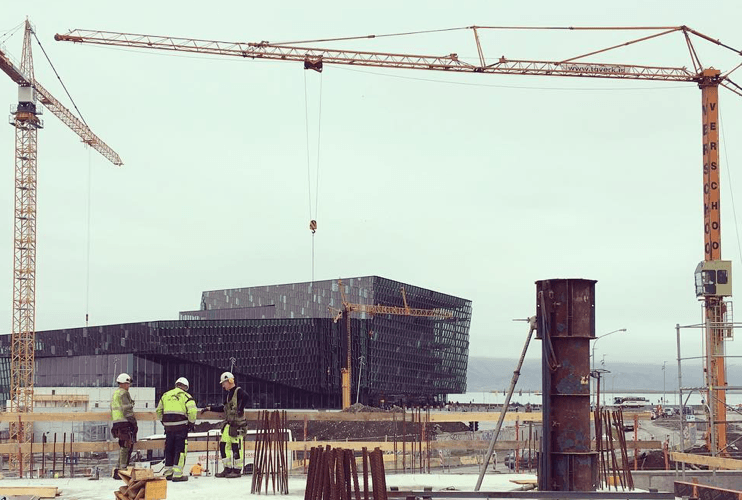As we’ve shown on our blog, smart access control is relevant for all kinds of industries, from coworking to experience design. To inquire into what access control and locking technology mean for architects, we reached out to Björg Halldórsdóttir, an architect and design manager for Hafnartorg (The Harbour Square Project) in Reykjavík, Iceland. With a size of over 24.000 m2, including 1.700 m2 of coworking space, this was a large project with many important decisions that needed to be made.
When thinking about the target audience for access control providers, one traditionally thinks of building operators, site owners or administrators, or residential and industrial end-users. However, there is a group that is often overlooked.
This group is the people who design the building: the architects.
Architects may not have the deciding vote when it comes to choosing locking solutions for the buildings they’re designing. However, for those operators who lack knowledge or experience when it comes to choosing access control, they often consult with the architect designing the building.
Some architects have years of experience of designing buildings in a specific sector, for example, hospitality or office spaces, and have worked with specific access control providers before. First and foremost, they might have an opinion about the look of the locks chosen, and whether it matches the aesthetics of the building.
Read on to find out what smart access control means to Björg.
What is the importance of smart lock solutions to you as an architect, and what do you look for in regards to access control?
As an architect, the first thing you look for in a smart lock solution is a product that is aesthetically pleasing. It may not be ideal, but it is the truth.
Secondly, the access control system has to fit the client’s needs. Most clients nowadays prefer smart, electronic locks, depending on the level of security needed for the building. However, some still prefer to use mechanical keys. These preferences must be discussed before starting to search for the right locks for the building.
Do you think that it is important for architects to think about access control when they are designing a space, or is it something that is solely the responsibility of the building manager?
I do think it's important to discuss access control at the initial design stage. It has been proven many times that the most successful building projects are the ones where the whole team works as one. Design managers and architects come from the opposite end of the spectrum and can, therefore, point out different aspects of a design element to one another, resulting in the most suitable choice for the client and the building users.
At what stage during the design process do architects need to think about access control?
At the initial design stage, it is important to get an idea of how the flow of people will be through the spaces. Learning about the client’s wishes regarding access control plays a vital part in that process. This also affects the fire safety design of the building, which means that it cannot be an afterthought.
At the later stages of the design process, when choosing materials, building elements and equipment, there needs to be a discussion with the whole design team and the client to make sure that his wishes are being met and that the chosen product fits the overall interior design. Furthermore, it needs to be established that the product can be delivered within the given time frame.
How important is it to be able to customize the look and finish of the lock, such as with SALTO Systems’ MyLock?
As I previously mentioned, the look of the locks is everything to an architect. It is extremely satisfying for an architect to be able to customize the finish of a product that affects the everyday usage of a building so much. The ability to create a holistic design is always the end goal, and SALTO Systems’ MyLock plays a huge part in achieving that goal.

Have you had any projects where you had to think about locking technology?
Yes. In a recent project for the headquarters of Regus in Iceland at Hafnartorg, access control was an important topic. Although the client already had a product in mind from the start it was still a constant discussion throughout the design process. I’m pleased to say that the end result was a success, both aesthetically and functionally.
Finally, are there any features you would like to see in locking technology in the future?
Customized locking technology for main doors to buildings is something I’d love to see in the future. Although being able to choose the colour and finish, as with SALTO’s MyLock, is a great start, I’d like architects to be able to fully design custom made handles themselves.
“I do think it's important to discuss access control at the initial design stage. It has been proven many times that the most successful building projects are the ones where the whole team works as one.” - Björg Halldórsdóttir, Architect and Design Manager of Hafnartorg.

Thank you, Björg, for taking the time to give us your insights into an architect’s perspective on smart access control.
To read more about SALTO KS, click here or follow us on Instagram and LinkedIn for the latest product features, team updates and news from the industry.
SALTO KS provides a flexible access control management system that requires no software installation or the added expense of a fully-wired electronic product. Modern cloud-based, wireless access control systems are easy and simple to use for businesses including Coworking Spaces, Coliving Buildings, Purpose Built Student Accommodation, Retail, Multi-Tenant Housing, Gyms and many more. Our best in class wireless access control solution and smart locks guarantee the efficiency for your business. Integrate smart locks, start easily managing wireless access control now!

